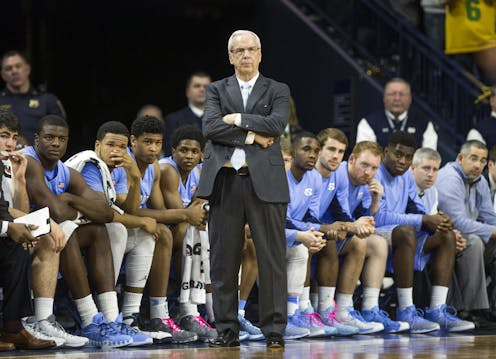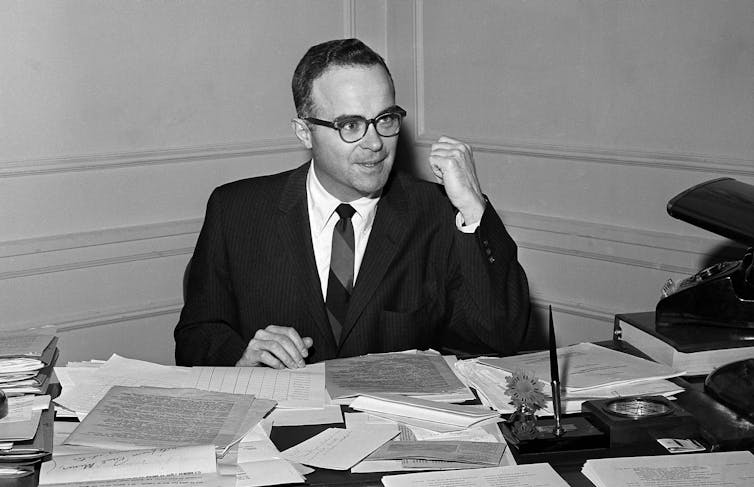In scandal after scandal, NCAA takes fall for complicit colleges
If we think about universities as corporations and their sports teams as marketing tools, everything about the UNC academic scandal – and the nonresponse – makes perfect sense.

College sports fans probably weren’t surprised to learn that the University of North Carolina (UNC) had been engaged in academic fraud for decades. In this particular instance, students, predominately varsity athletes, were enrolled in classes with few (if any) academic requirements. They almost always received high grades.
The UNC scandal is just one of many recent examples where universities have prioritized athletic prowess over academic integrity.
And where was the National Collegiate Athletic Association (NCAA) in all this? Amazingly, it essentially shrugged off the apparent transgressions, even after UNC admitted to them. Is the NCAA abdicating its oversight responsibilities?
Critics of the NCAA, such as Bloomberg News’ Joe Nocera, have long argued that the organization has zero credibility as a regulator of college sports. Nocera and others tend to view the NCAA as either hypocritical or corrupt.
But without appearing sympathetic to the NCAA, I believe it is not the prime offender in the UNC case. It is simply doing the bidding of a higher education system that has gone off the academic rails. If the NCAA is Oz’s projection on the wall, a profit-oriented higher education system is behind the curtain pulling the levers.
The athletic arms race
In my recent book, I link higher education’s misplaced priorities to the explosion of costs associated with intercollegiate athletics and youth sports.
This research, along with studies by the Knight Commission, the Drake Group and the Association of Research Libraries, shows that university spending on intercollegiate sports has vastly outpaced spending on instruction and research over the past two decades.
This spending spree has led to an arms race, or what sports sociologist Howard Nixon II calls an “athletic trap” that ensnares universities in incessant funding of high-visibility sports programs.
Contrary to popular belief, very few college sports programs operate in the black. According to data from the NCAA and U.S. Department of Education, fewer than 25 of the more than 300 NCAA Division I programs earn more than they spend. Athletic department deficits at some schools run upwards of US$20 million per year.
Whenever athletic expenses exceed revenues, schools must make up the gap through other means.
At state schools, this could include more public funding, although that is becoming quite rare. More likely, schools will try to address the deficit through increasing tuition, implementing generic “student fees” or soliciting alumni for more money.
Paying for what, exactly?
On the surface, none of this seems logical. Why pour so many resources into athletic programs? If students end up bearing the financial burden and education programs suffer, where is the return on the investment?
More than 100 years ago, sociologist Thorstein Veblen first identified the “corporatization” of higher education, with university presidents as “captains of solvency” who focus their energies on “principles of spectacular publicity” that will impress current and future donors.
Not much has changed in the last century. Higher education has become more about cultivating a school’s “brand” than cultivating critical thinkers, more about alumni checkbooks than about student notebooks. Is it any wonder that college presidents are increasingly referred to as CEOs and are being recruited from the corporate world?
If we think about college sports as a marketing venture rather than an educational venture, all of this spending makes perfect sense. Think of players as walking advertisements – each branded with the school’s logo – who appear before millions of viewers on ESPN and ABC
Large schools are especially concerned with brand development and revenue streams, which come from a combination of dedicated alumni, fans and corporate sponsors.
Meanwhile, smaller Division I schools and Division III schools use athletics not just for brand recognition but to manipulate their enrollment statistics and improve their “selectivity index.”
Generally, varsity athletes are admitted through an early decision process that operates somewhat independently from the regular admissions process. But only the regular process figures into calculations of a college’s acceptance rates. Athletes who are admitted early reduce the number of acceptances offered to the regular applicant pool.
This lowers the school’s acceptance rate and raises its perceived selectivity – all without any substantive educational improvements.
Like their Division I counterparts, Division III schools also believe that visible and successful sports programs will spawn increased alumni contributions. The supporting data for this, however, are mixed. Most schools end up treading water (or slowly sinking) as increased spending doesn’t keep pace with increases in alumni contributions.
The empty ‘student-athlete’ slogan
Officially born in 1910, the NCAA has always had trouble balancing its dual mission of promoting and regulating intercollegiate sports. Part of this promotion has been cultivating the “amateur” status of college sports, and how it is “purer” than commercialized professional sports.
Nothing represents that marketing scheme better than the “student-athlete” concept.
Former NCAA president Walter Byers first coined the term in the 1950s while fighting a worker’s compensation claim by the widow of a college football player who had died during a game. “Student-athlete” has since becoming something of a mantra among those who work at any level within intercollegiate sports.

As a result, the NCAA postures as a de facto defender of academic integrity, even while its bylaws state otherwise. Rules approved by the NCAA in 2016 state that colleges should set their own academic integrity standards, with the NCAA intervening only when those internal rules are violated.
In the UNC case, the NCAA is refusing to second-guess the school’s determination that no internal rules have been violated, despite what appears to be serious academic misconduct.
Following the NCAA’s statutory logic, universities would crack down on athletics-centered academic fraud if they really wanted to. Instead, as my research and the work of others show, schools have become organizationally and ideologically addicted to intercollegiate sports.
Universities are convinced that they only need one more “fix” to reach intercollegiate sports nirvana: just one more new facility, one more high-profile coach, one more no-work course and one more entertainment complex to attract top recruits. But the athletics arms race keeps spiraling, and higher education keeps moving farther away from its educational mission.
The NCAA is a convenient scapegoat, but the problem lies much deeper. Is “college education” itself becoming an oxymoron? Was long-time college sports critic Murray Sperber correct when he said that universities were more about “beer and circuses” than about teaching and research?
Perhaps Thorstein Veblen was also right when he originally subtitled his book on higher education “A Study in Total Depravity.”
Rick Eckstein does not work for, consult, own shares in or receive funding from any company or organization that would benefit from this article, and has disclosed no relevant affiliations beyond their academic appointment.
Read These Next
As DOJ begins to release Epstein files, his many victims deserve more attention than the powerful me
Powerful men connected to Jeffrey Epstein are named, dissected and speculated about. The survivors,…
It’s more than OK for kids to be bored − it’s good for them
Boredom is a healthy part of life. Experiencing it can help children learn to set goals and make plans.
As millions of Americans face a steep rise in health insurance costs, lawmakers continue a century-l
US health care policy will remain fractured until lawmakers address the core question of who is responsible…






